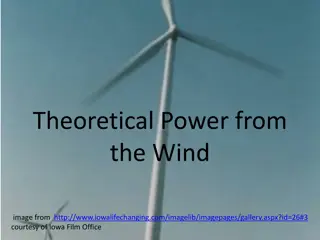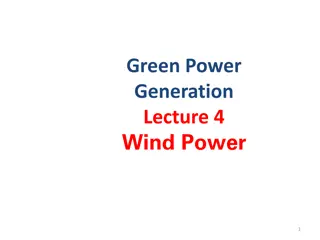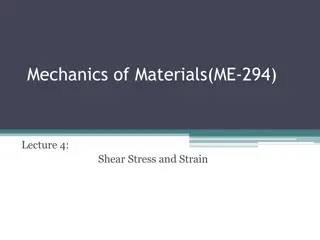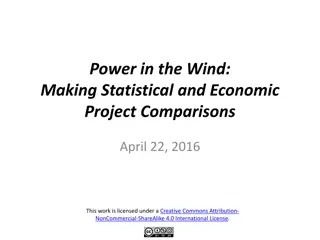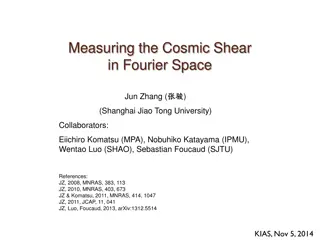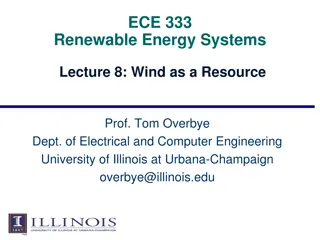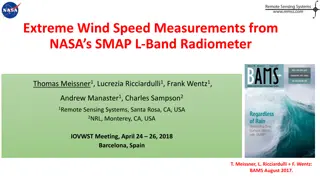Influence of Vertical Wind Shear on Entrainment in Squall Lines
The strength and direction of low-level (LL) and upper-level (UL) wind shear influence the properties of squall line updrafts, with stronger shear environments fostering wider updrafts that are less susceptible to entrainment-driven dilution. The relative influences of LL and UL shear on this relationship are important considerations in understanding the dynamics of squall lines. Entrainment plays a crucial role in modulating updraft characteristics and redistributing key atmospheric components. This study delves into the impact of vertical wind shear on the entrainment process within squall lines, shedding light on the complex interplay between shear and updraft behaviors.
Download Presentation

Please find below an Image/Link to download the presentation.
The content on the website is provided AS IS for your information and personal use only. It may not be sold, licensed, or shared on other websites without obtaining consent from the author.If you encounter any issues during the download, it is possible that the publisher has removed the file from their server.
You are allowed to download the files provided on this website for personal or commercial use, subject to the condition that they are used lawfully. All files are the property of their respective owners.
The content on the website is provided AS IS for your information and personal use only. It may not be sold, licensed, or shared on other websites without obtaining consent from the author.
E N D
Presentation Transcript
How does vertical wind shear influence entrainment in squall lines? Mulholland, J. P., J. M. Peters, and H. Morrison, 2021 J. Atmos. Sci, 78 78, 1931 1946. R10229003
Outlines Introduction Experimental design Results Summary, discussion and conclusions
Introduction The strength and direction of LL shear that occurs over the depth of the cold pool regulates updraft tilt and speed.(Hane 1973, Thorpe et al. 1982, etc.) RKW theory : the ratio of the LL shear magnitude to the cold pool intensity Squall lines in environments with stronger LL shear have stronger updrafts Substantial UL shear is also found within squall-line environments.(Davis et al. 2004) Strong mid- to upper-level winds also influence the cold pool speed via downward momentum transport. Strong UL shear may also influence squall line motion via changes in steering flows aloft. (Mahoney et al. 2009)
Introduction The importance of variations in both LL and UL shear collectively on squall-line updraft properties is largely unknown. Seldom been discussed in the context of squall lines is entrainment. Entrainment typically results in dilution of updraft buoyancy, leading to a reduction in vertical accelerations and vertical velocities (w). Entrainment modulates the updraft, and the updrafts vertically redistribute heat, moisture, momentum, and chemical constituents. A key role in the generation of large hail, damaging winds, tornadoes, lightning, and heavy rainfall.
Introduction Squall lines system Typically depicted a structure with deep convective updrafts along an OFB. A tongue of high equivalent potential temperature and conditionally unstable air that slopes up and over the cold pool colloquially known as front-to-rear flow slab-like ascent. (Zipser 1977; Houze 1989, .etc) Often breaks down into discrete, quasi spherical updraft pulses thermals in the middle to upper troposphere, with order of 1 2 km. (Redelsperger and Lafore 1988; Weisman et al. 1988, .etc) The thermal-like structure of middle- to upper-tropospheric squall-line updrafts suggest that they are susceptible to the deleterious effects of entrainment. (Morton et al. 1956; Scorer 1957, .etc)
Scientific Questions 1) Do environments with stronger shear also foster wider squall-line updrafts than environments with weaker shear, and are squall-line updrafts in stronger-shear environments therefore less susceptible to entrainment-driven dilution? 2) What are the relative influences of LL and UL shear on this relationship?
Hypothesis Stronger LL shear in squall-line environments equate to stronger LL OFB- relative flow, greater LL horizontal mass flux into the edge of the cold pool, and thus wider squall-line updrafts with less entrainment-driven dilution. The wider squall-line updrafts in environments with stronger LL shear equate to larger updraft B, and consequently w. Expect a similar relationship between UL shear. LL shear should have a greater influence than UL shear : The connection between LL shear and both LL OFB relative flow and LL horizontal mass flux.
Experimental Design Numerical modeling setup Idealized numerical model simulations in Cloud Model 1 (CM1; Bryan and Fritsch 2002) release 19.7. Resolution : ? = ? = ? = 250? ??= 420??,??= 99??,??= 25?? ??? Rayleigh dampening coefficient 3.33 10 3? 1layer applied z > 20km Periodic lateral boundary conditions on Y-axis Open radiative lateral boundary conditions on X-axis The lower and upper boundaries were free slip with a rigid domain top Results in coarser ( ? = ? = 1km) simulations were qualitatively similar
Experimental Design Numerical modeling setup Neglected radiation, surface fluxes, friction, terrain, and Coriolis force Microphysics : Morrison two-moment scheme(Morrison et al. 2009) with hail set as the prognostic rimed ice hydrometeor species Time step = 3.5 s, 1output/5min Total Time = 8 h
Experimental Design Base-state environments Based on Weisman and Klemp (WK82) Modifications: Increasing the surface ? : 300 to 302K Reduce the amount of errant convection that occurred ahead of the squall-line OFB Reduce the RH >2.5km AGL to 45% More like the observed squall-line environments The modified PBL mixing ratio = 14 g/kg
Experimental Design Base-state environments 0-1km Mean Layer Most Unstable [J/kg] Surface CAPE 2043 2191 2615 CIN -69 -44 -3 All fall within the range of observed values for squall-line environments The approximate effective inflow layer depth (EIL) ~2.5 km Thompson et al. (2007) Largest contiguous vertical layer with CAPE > 100 J/kg & CIN < -250J/kg
Experimental Design Base-state environments A cold pool covering the domain from S-N and extending from the center to W. The minimum surface ? perturbation of the cold pool was set to -5K and decreased in magnitude toward 0 K with height. Depth = 2.5 km 0.25 K random ? perturbations in the I.C.
Experimental Design Base-state environments Three different LL (0 2.5 km AGL) and UL (2.5 10km AGL) vertical wind shear magnitudes constituted our simulation matrix Within the range of magnitudes used in prior squall-line simulation studies and also in observations LL3 represents the far high end of the LL shear spectrum for observed squall lines in environments with substantial CAPE UL3 is likely at the low to moderate end of the UL shear spectrum
Experimental Design Quantifying entrainment-driven dilution A passive tracer (PT) was initialized in the base state to the E. of the cold pool 0~1.5 km AGL (light red shading) The lower half of the EIL(~2.5km), where CAPE???.located PT concentration in updrafts falls below 100% is used to quantify the degree of entrainment-driven updraft dilution
Experimental Design In-line forward parcel trajectories In-line forward trajectories in the LL1_UL1, LL1_UL3, LL3_UL1 & LL3_UL3 At T = 4hr, 1000 trajectories were initialized ahead of the squall-line OFBs. Trajectories were placed in a 10 km S-N line at 100 km east of the domain center and spanned between 25 and 835m AGL, covering the lower EIL. Trajectories were calculated with a time step consistent with the model simulations (3.5 s) with output written every time step. Compare the contribution of B versus the vertical perturbation pressure gradient accelerations (VPG) to ????along the trajectories among the four different simulations.
Results General attributes of simulations The 4 7-h averaged lowest level (125m) [dBZ] All simulations produced squall lines with many features of observed squall lines A stratiform region that trailed the leading deep convective line
Results General attributes of simulations The 4 7-h averaged lowest level (125m) [dBZ] LL1: broken into cellular features Increase in LL led to more widespread structures UL shear had relatively muted impacts UL in LL1 & LL3 resulted differently Bowing segments in LL3_UL3
Results General attributes of simulations We assessed the relative balance between the cold pool-induced circulation and LL shear-induced circulation for the simulated squall lines. This was accomplished by calculating the C/ ? ratio ? ? ??, C = 2 0 H = cold pool depth, the height of the -1K ? contour ? = the zonal shear over the depth of the cold pool ? ?0+ invariant ?0 ?? ?? 1 ?? ??, ? is perturbation from the horizontally ? = ?
Results General attributes of simulations According to RKW theory: C/ ? >> 1 : moist updrafts tilt rearward over the cold pool C/ ? 1 : moist updrafts are approximately vertically oriented Near center of the domain : LL1 : C/ ? >4, LL3 : C/ ? 1.5 All simulations updrafts should slant rearward over the cold pool
Results General attributes of simulations vertical cross sections of PT concentration (shaded %) vertical velocity (1m/s contour in light blue) reflectivity (20 dBZ contour in dark gray) 4 7-h period -5~+5km around the domain center PT concentration, w, and reflectivity Weaker LL has weaker & shallower updrafts Stronger LL has stronger & deeper updrafts
Results General attributes of simulations vertical cross sections of PT concentration (shaded %) vertical velocity (1m/s contour in light blue) reflectivity (20 dBZ contour in dark gray) OFB closer to deep convective line in stronger LL The OFBs were effectively detached from the middle- to upper-tropospheric updrafts in LL1 Weaker LL displayed greater dilution of the EIL PT aloft.
Results General attributes of simulations vertical cross sections of B (shaded ?/?2) vertical velocity (2m/s contour in green) In-plane wind vectors (m/s) 4 7-h composites of B and w in -5~+5 km Large horizontal expanses of positive B in all squall lines above ~4 5 km AGL regardless of shear magnitude LL1 updrafts more slant than in LL3, consist with RKW theory
Results Influence of shear on updraft width and entrainment-driven dilution Updraft area : Contiguous horizontal regions that met a certain w threshold at each model vertical level. Excluding areas of small-scale vertical motion (areas < 1 ??2). broad (w > 5 m/s) and core (w > 20 m/s) updrafts.
Results Influence of shear on updraft width and entrainment-driven dilution Broad & core updraft area increased with increasing LL shear UL shear have less pronounced effect than LL shear The large broad updraft area below ~2.5 km were related to the front-to-rear slab-like ascending airstreams
Results Influence of shear on updraft width and entrainment-driven dilution The larger regions of slab-like ascent appears to set the stage for wider thermals aloft Correlation coefficient =0.81; p value < 0.05 between average 0 5 km AGL broad updraft area and average 5 10 km AGL core updraft area over the 4 7-h
Shading unit [??2] Lower right : 95% confidence interval around the median values Results Influence of shear on updraft width and entrainment-driven dilution LL shear increased 0-5 km AGL broad updraft area increased Similar to 5 10 km AGL core updraft area updraft width appears to be more strongly influenced by LL shear than by UL shear
Results Influence of shear on updraft width and entrainment-driven dilution The median 5 10 km AGL layer max. PT concentrations show that stronger LL shear equated to larger PT concentrations aloft There was no statistically significant connection between UL shear and PT concentration Median 4 7-h 5 10 km AGL layer maximum PT concentration Lower right : 95% confidence interval around the median values
Results Influence of shear on updraft width and entrainment-driven dilution Maximum PT concentrations and average 5 10 km AGL core updraft area were statistically significant (p value ,0.05), with a log-scaled CC = 0.83 Squall-line updrafts with stronger LL shear displayed less entrainment-driven dilution
Results Updraft width and entrainment-driven dilution Morrison (2017). Simple eddy diffusivity approximation for lateral mixing of environmental and updraft air PTTH= PTTH,???? ??,PTTH,???is assumed 100%, ? = 2?2?/(???2) k is a nondimensional scaling constant (set here to 0.18) L is a turbulent mixing length : set to grid spacing (250 m) ??is a turbulent Prandtl number which is set here to 1/3 R is assumed to be constant with height [Morrison (2017)] Axisymmetric updrafts were assumed ? = ??eff,?eff= (?/?)1/2 Max. PT concentration ~ z = 5km
Results Updraft width and entrainment-driven dilution The closeness of the PTTHconcentration curve (green line) supports a 1/?2 scaling 1/R scaling [dry plumes & thermals, Morton et al. 1956; Scorer 1957] gives a poorer comparison with PTTH(gold line)
Results Influence of shear on updraft width and entrainment-driven dilution The connection between LL shear and updraft width is evident in the statistically significant correlations (CC=0.79; p value <0.05) The LL shear is directly connected to the LL horizontal mass flux and connected to the vertical mass flux via mass continuity.
Results Updraft width & entrainment-driven dilution on ???? LL shear increased, ????increased. UL shear effect is not evident Thermodynamic speed limit 2?????? ~ 72.3 m/s 95% of the speed limit in LL3_UL3 at T = 1 h 60~70% of the speed limit in LL1_UL1 Similar to the squall-line simulations analyzed in Lebo and Morrison (2015) Median 4 7-h ????[m/s] Lower right : 95% confidence interval around the median values
Results Updraft width & entrainment-driven dilution on ???? Stronger LL shear equates stronger ????along the LL OFBs (~ <2.5 km AGL) Height of ????corresponded with thermals aloft (>5km AGL) rather than LL OFBs Variations in UL shear had the largest impact in LL3 simulations
Results Updraft width & entrainment-driven dilution on ???? Maximum parcel displacements were substantially larger in the stronger LL shear simulations Updrafts experiencing stronger LL shear were faster and deeper UL shear had lesser impact on maximum parcel displacements Maximum parcel displacements (km) across all usable trajectories Horizontal lines in each violin plot represent the 5th (lower) and 95th (upper) confidence intervals around the median values Dots in each violin plot represent the 5th (lower) and 95th (upper) confidence intervals around the 90th-percentile values.
Results Updraft width & entrainment-driven dilution on ???? The 4 7-h ????were statistically significantly correlated (CC =0.71 p value <0.05) with average 5 10 km AGL core updraft areas Less entrainment-driven dilution associated with wider updrafts in the stronger LL shear simulations Wider updrafts in the simulations with stronger LL shear were more buoyant because of their decreased dilution
Results Updraft width & entrainment-driven dilution on ???? Inviscid vertical momentum equation ?? ??= ? 1 Peters et al. (2019b) ?? ?? ? ? =???? + 2 ? =?0 ? =? 1 ?? ???? (?2)? ?2 ?0= 2 ? =?0 ? ? =???? (Assume ??2?0 = 0 ?/?) The buoyant contribution to w is given as ??2= 2 ? =?0 The height of ??,???was often slightly higher than the height of ???? Downward-oriented dynamic PGA near cloud top Not appreciably impact the magnitude of ????
Results Updraft width & entrainment-driven dilution on ???? Violin plots of ????& ??,??? across all trajectories showed a positive correspondence between LL shear, ????& ??,??? Larger B in the simulations with stronger LL shear contributed to larger vertical accelerations and larger ???? UL shear had much less impact Horizontal lines in each violin plot represent the 5th (lower) and 95th (upper) confidence intervals around the median values Dots in each violin plot represent the 5th (lower) and 95th (upper) confidence intervals around the 90th-percentile values.
Results Updraft width & entrainment-driven dilution on ???? The VPG accounts for a larger fraction of positive acceleration than B at weaker magnitudes of ???? At stronger magnitudes of ????the percentage of acceleration from B was considerably larger than from VPG Largest ????magnitudes were primary modulated by changes in B, and therefore by changes in entrainment-driven dilution owing to changes in updraft width B (solid lines %) and VPG (dashed lines %)
Summary, discussion and conclusions For a singular thermodynamic environment (i.e., fixed CAPE and CIN): LL shear increased, LL horizontal mass flux increased, leading to wider squall-line updrafts that were stronger and deeper. Wider updrafts in stronger LL shear environments least amount of entrainment driven dilution of B, consistent with larger concentrations aloft of PT . Statistically significant correlations were found between LL horizontal mass flux, updraft width, PT transport aloft, and ????. Changes owing to variations in UL shear were relatively minor. Forward trajectory analyses : Larger B in wider, less dilute updrafts resulted in larger vertical accelerations and ????.






